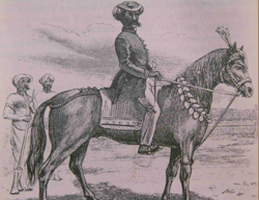The family has been remembered for their brave fight against the Portuguese. The family is considered to be originally from Rajaputana (Rajasthan). In the service of the Bhonsle king of Sawantwadi they were given the lands that comprises of present day Sattari taluka. The Portuguese had signed a treaty with the Raja of Sawantwadi. As per the treaty the Portuguese were to help the Raja of Sawantwadi in case of emergency.
When emergency did arise the Raja called for help against the Bhonsles of Kolhapur. Portuguese instead occupied his territory of Pernem, Bicholim and Sattari. Ranes were in charge of Sattari who in return for their continued feudal control of the territory agreed to ally with the Portuguese.
The Portuguese later on attempted to entail the powers of the ruling Rane clan on many occasion. This led to Ranes rising in revolt against the Portuguese from time to time. Out of the four major revolts that the family undertook against the Portuguese regime, three were very successful.
Chronology of the revolts
1852 – 1855 – Dipaji Rane revolted against the Portuguese. He captured the fort of Nanuz in Sattari and launched his attacks from there. This went on for around five years. Finally the Portuguese authorities made peace with Dipaji Rane and pardoned all the rebels restoring their rights.
1869 – 71 – The revolt was led by Kustohba Rane. He wreaked havoc in the Portuguese territories for two years. He was assassinated outside his house on June 13, 1871.
1895 – This revolt was coupled with a soldier mutiny. The soldiers mutinied because they were being forced to leave Goa and fight in Portuguese colony of Mozambique in Africa. This was a time when crossing the sea was considered a sin. In Sattari the Ranes again were facing problems from the Portuguese authorities.
The soldiers and the Ranes joined hands together. Dada Rane was proclaimed the leader of the revolt and successfully captured the Aguada fort. From here he planned to attack the city of Panjim. Many residents fled in fear of the rebels, some moved to Vasco Da Gama and some to the faraway Belgaum (Belgavi). The Portuguese were again forced to make peace with the Ranes.
1912 – In the ensuing years. An assassination incident of an army officer of the Portuguese led to some members of the Rane family being deported to the Portuguese colonies in Africa. After Santoba returned from his imprisonment in Africa he rose in revolt. This time though the Ranes were defeated and about 250 rebels were deported to Portuguese colonies in West Africa.
Current situation
The Portuguese had no trouble from the family after 1912. After the liberation one member of the Rane clan became a hugely successful politician of Goa. Pratapsingh Raoji Rane has served six times as the Chief Minister of Goa. Currently he is the Leader of Opposition in the Goa Assembly.
The family has often been criticized for the reasons of their revolt. It has often been said that the revolts were out of personal motivation rather than patriotism towards Goa. Whatever the reason, they are the family that brought the Portuguese to their knees three times!
Source – Window on Goa by Maurice Hall, Rajhauns Year Book 2015,


